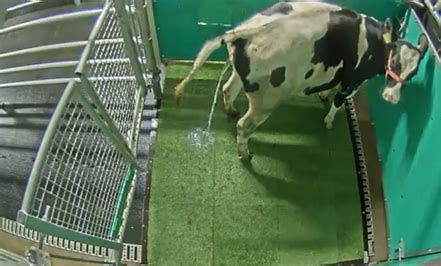
A herd of cows has been “potty-trained” in an experiment that scientists say could pave the way for more environmentally friendly farms.
Waste from cattle farms often contaminates soil and waterways and contributes to greenhouse gas emissions and the acidification of soil. For this reason, toilet-training cattle has long been viewed as desirable, but several previous attempts have been unsuccessful.
The success in training cows – may be later other livestock – happens at a time when it is estimated that 673 million people in the world still practise open defecation and an estimated 367 million children attend a school with no sanitation facility at all.
In the latest study, scientists tried a method they called the MooLoo approach to teach calves to use a toilet area in their barn, meaning that urine could be collected and treated.
“Cattle, like many other animals, are quite clever and they can learn a lot,” said Jan Langbein, an animal psychologist at the Research Institute for Farm Animal Biology (FBN) in Germany. “Why shouldn’t they be able to learn how to use a toilet?”
The calves were trained via a system of rewards and mild punishments. When they urinated in the assigned area, they were given a sweet drink or some mashed barley, and when they relieved themselves elsewhere, they were surprised by a short blast of water from above.
“It’s usually assumed that cattle are not capable of controlling defecation or urination,” says Langbein, but he and his team questioned this thinking. “Cattle, like many other animals or farm animals are quite clever and they can learn a lot. Why shouldn’t they be able to learn how to use a toilet?”
Within a few weeks, after about 15 training sessions, 11 out of the 16 calves in the experiment had been successfully toilet-trained, according to the study published in the journal Current Biology. The five calves who were not reliably trained probably just needed more time to master the skill, the authors suggested. Langbein said a future ambition would be to teach cows to also defecate in a toilet area.
The team are now working to create an automated system that could be used to train calves with almost no intervention from farmers. “We want to develop some kind of sensor technology, which is all-inclusive,” said Langbein. He said that his hope was that “in a few years all cows will go to a toilet”.
The ammonia produced in cow urine doesn’t directly contribute to the climate crisis, but when it leaches into the soil, microbes convert it into nitrous oxide, which is the third most significant greenhouse gas after methane and carbon dioxide.
Agriculture is the largest source of ammonia emissions, with livestock farming making up more than half of that contribution.
According to Langbein, initial estimates suggest that if 80 per cent of cattle urine was collected from a barn, the ammonia emissions would be reduced by more than half.
On a farm where cows freely relieve themselves as they graze, the accumulation and spread of waste often contaminates local soil and waterways.
Scientists now say this can be controlled by confining the cows in barns, but in these close quarters their urine and faeces combine to create ammonia, an indirect greenhouse gas.
In an article published on September 13 in the journal Current Biology, researchers show that cows can be potty-trained, enabling waste to be collected and treated, thereby cleaning up the barn, reducing air pollution, and creating more open, animal-friendly farms.
“You have to try to include the animals in the process and train the animals to follow what they should learn,” says Langbein. “We guessed it should be possible to train the animals, but to what extent we didn’t know.”
To encourage latrine use, the researchers wanted the calves to associate urination outside the latrine with an unpleasant experience.
“As a punishment we first used in-ear headphones and we played a very nasty sound whenever they urinated outside,” says Langbein. “We thought this would punish the animals – not too aversively – but they didn’t care. Ultimately, a splash of water worked well as a gentle deterrent.”
- A Tell report











